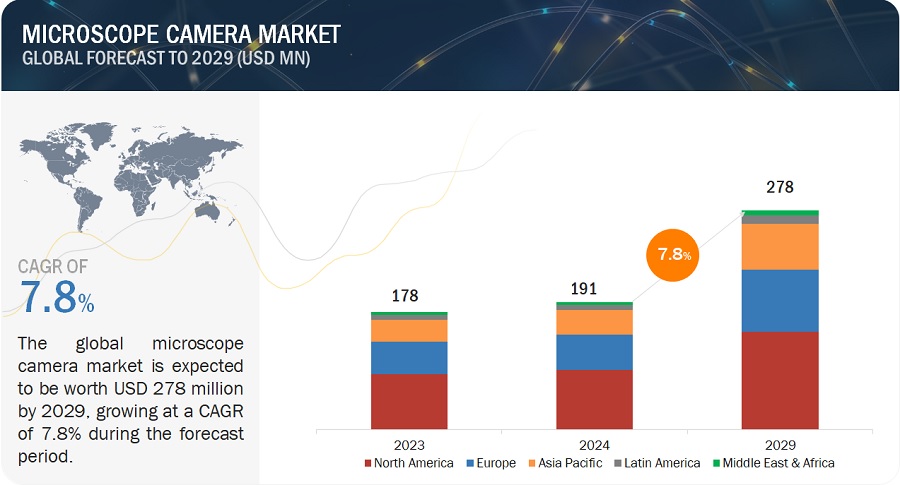The global microscope camera market is growing at a CAGR of 7.8% and is expected to reach USD 278 million by 2029, up from USD 191 million in 2024. This growth is driven by the rising prevalence of chronic diseases and ongoing technological advancements, particularly in high-growth regions such as Asia Pacific. Challenges like high production and maintenance costs persist, but the shift towards CMOS sensors and the increasing demand for high-resolution cameras are key trends. The market is divided into segments based on type (color vs. monochrome), sensor type (CMOS vs. CCD), resolution (SD vs. HD), application (e.g., pharmaceutical research), and end-user (e.g., pharmaceutical companies). North America leads the market, with major players including Leica Microsystems, Nikon, and Carl Zeiss.

Browse in-depth TOC on "Microscope Camera Market"
259 - Tables
54 - Figures
235 - Pages
Camera Type Segmentation
The microscope camera market is divided into monochrome and color cameras. Color cameras are preferred due to their ability to produce color images more efficiently compared to monochrome cameras, which require additional hardware and multiple images to achieve color. The need for accurate molecular analysis using colored reagents further supports the dominance of color cameras, which held a larger market share in 2023.
Sensor Type Segmentation
Microscope cameras are categorized by sensor type into complementary metal oxide semiconductor (CMOS) sensors and charge-coupled device (CCD) sensors. CMOS sensors led the market in 2023 due to their superior features, including lower noise levels, higher sensitivity, and better image quality. CMOS sensors offer advantages such as lower power consumption, faster frame rates, and reduced manufacturing costs compared to CCD sensors.
Resolution Segmentation
The market is also segmented based on resolution into standard-definition (SD) and high-definition (HD) cameras. The HD cameras segment dominated in 2023 and is expected to maintain its lead throughout the forecast period. The growing demand for high-quality images in medical applications and the overall preference for HD cameras contribute to this segment's large market share and higher anticipated growth rate.
Application Segmentation
Applications of microscope cameras include live cell imaging, pathology, pharmaceutical & biopharmaceutical research, among others. In 2023, the pharmaceutical & biopharmaceutical research segment held the largest market share at 45%, followed by live cell imaging. This dominance is due to the increasing use of microscope cameras for tasks such as biomarker research and protein structure analysis.
End-User Segmentation
The market is segmented by end-users into pharmaceutical & biopharmaceutical companies, hospitals & diagnostic laboratories, academic & research institutes, and other entities like CROs and forensic labs. The pharmaceutical & biopharmaceutical companies segment holds the largest share, driven by the essential role of microscope cameras in research, drug profiling, and development stages of pharmaceutical drugs.
Regional Analysis
The microscope camera market spans six major regions: North America, Europe, Asia Pacific, Latin America, the Middle East & Africa, and GCC Countries. North America leads the market, supported by the adoption of advanced technologies, substantial government and public funding for life sciences research, and the presence of key market players. The region's strong investment in DNA-based testing and its growing use of cameras in diagnostic labs further bolster its market position.
Key Market Players
Major players in the microscope camera market include Leica Microsystems (Danaher Corporation, US), Nikon Corporation (Japan), Carl Zeiss AG (Germany), Teledyne Technologies (US), and EVIDENT (Japan), among others. Notable companies also include Jenoptik AG, Hamamatsu Photonics KK, Basler AG, Excelitas Technologies, and several others, each contributing to the diverse product offerings in the market.
Leica Microsystems
Leica Microsystems (Danaher Corporation, US) led the microscope camera market in 2023, holding a 17.8% share. The company's leadership is attributed to its comprehensive product range, which includes color and monochrome cameras with CCD, CMOS, and sCMOS sensors, as well as HD and UHD resolutions. Leica Microsystems maintains a strong global presence and focuses on product innovation, partnerships, and collaborations to sustain its market dominance.
For more information, inquire now! Inquire Now
Nikon Corporation
Nikon Corporation (Japan) ranked second in the microscope camera market with a 15.3% share in 2023. Nikon specializes in optics, microscopes, and imaging products used in medical imaging for support, diagnosis, research, and training. The company aims to enhance its market position by forming strategic agreements and partnerships and launching new products to expand its portfolio.
Content Source:
https://www.marketsandmarkets.com/Market-Reports/microscope-camera-market-155714096.html
https://www.marketsandmarkets.com/PressReleases/microscope-camera.asp
